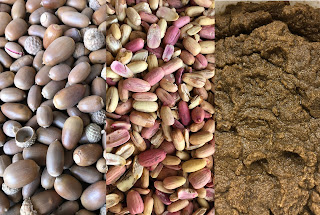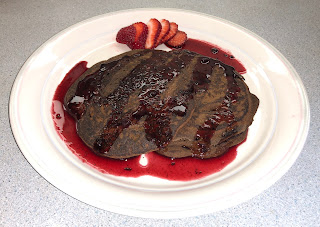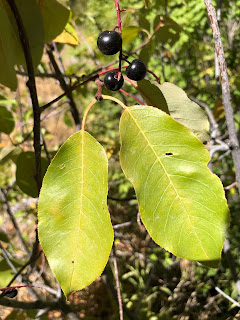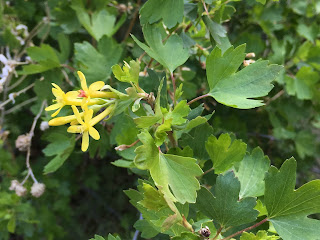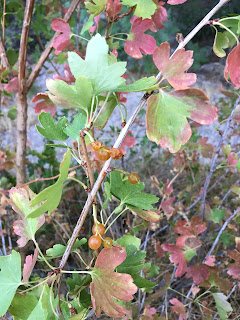 |
| Cardaria draba |
Cardaria draba is a great wild substitute for broccoli. Just be sure you cook it first.
It's so good, I had to put the conclusion at the beginning, where I usually explain that
Cardaria draba is commonly known as Whitetop or Hoary Cress, and less commonly but more recently known as
Lepidium draba. Like broccoli, it is a cruciferous vegetable, which means it is a member of the mustard family, formerly (and more correctly) called the Cruciferae family in Latin. "Draba" comes from a Greek word meaning sharp, acrid or burning, which is an appropriate description of this plant.
Whitetop is a very common and invasive weed. If you don't already have it in your garden, one of your neighbors does, and it is easily found in practically every suburban setting. You probably see a lot of it next to your jogging path, for example.
I have heard from
many people that whitetop is edible, and have eaten it myself, and told others about it. The trouble with it is, it is extremely spicy when eaten raw, so I have not eaten very much of it at a time. But it looks like it would make a good broccoli substitute, if cooking could tame the spiciness. So on a trip to the mountains, I found a lot of it in prime condition, with the tops still in clusters of buds before the flowers open, and it was time to finally do the cooking experiments with it. I just pick the top bud clusters, along with any small leaves which came with it. Lower leaves seem a lot tougher. One can squat down in a patch and pick a lot before needing to get up to go to the next section of the patch. Squatting is better for your back than bending over.
 |
Whitetop Stir-Fry
with false solomon's seal, watercress,
mushrooms and onions,
in a stinging nettle and soy sauce |
And the cooking was a complete success. After 5 minutes of boiling, the flavor was fresh and mild, with practically all of the spiciness gone. Some people can still detect a little when they eat a lot of it. After 10 minutes, the flavor was about the same, but it had a mushier texture, so it doesn't need to be cooked that long. Next I steamed it for 5 minutes. This also removed that spiciness and resulted in the most similar taste to broccoli, both in flavor and texture. Finally, because I like broccoli in my stir-fry recipes (the buds hold on to the sauce very well--yummy), I made a stir-fry out of it, along with some
Smilacina racemosa (false solomon's seal) and
Nasturtium officinale (watercress) which I found on the same outing. I also added some mushrooms and onion, and made the sauce out of
stinging nettle and soy sauce. Very very good!
Note that some sources say there is hydrogen cyanide in the young leaves, but this is an over-simplification. The cyanide in
Cardaria draba (and other mustards) is in the form of isothiocyanates, glucosinolates, and in less chemical terms, erucic acid. These compounds are known to have a very spicy and/or bitter flavor. One study (
Nutrient composition of whitetop) says "Total glucosinolate content of whole whitetop plants during the rosette and early bloom stages of development approximated that of low-glucosinolate cultivars of rape." In other words, whitetop is no more dangerous than canola oil.
Older sources and those interesting grazing animals emphasize the negative effects of these compounds, which include anti-thyroid effects (therefore pro-goiter effects) and cardiotoxic effects in rats (not verified in humans). It is also said to taint milk and meat for about a week after ingestion. Newer studies prefer to emphasize the health benefits of isothiocyanates, which include antioxidant, anti-inflammatory, anti-bacterial, and multi-faceted anticancer activity. (
Here is a fairly readable article.) There are
various studies on the effects of cooking cruciferous vegetables, which confirm that boiling reduces these chemicals the most. Actually, most of those articles are concerned with finding the cooking methods which preserve isothiocyanates and glucosinolates because of their reputed healthy effects, but since whitetop is fairly high in these compounds, it is probably better to try to reduce them in cooking.
A couple of us did notice some mild stomach upset a few hours after eating our whitetop stir-fry. So remember the usual cautions to try new foods in small amounts to see how you react to them, and that boiling is probably the best way cook these if you are being cautious.
One reason why Cardaria draba is so invasive is that it releases allelopathic chemicals which reduce the growth of other plants. Cardaria draba is especially detrimental to grasses, including commercial cereal crops. So it may be a good idea to get it out of your garden.

